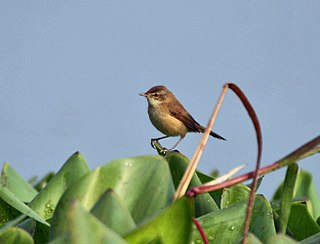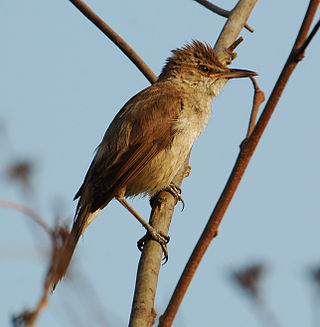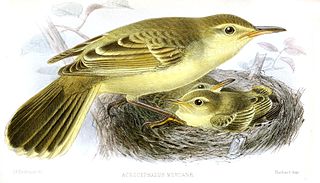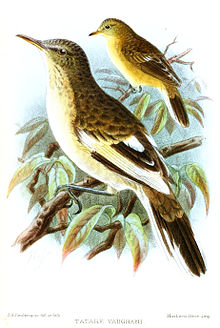
The Acrocephalus warblers are small, insectivorous passerine birds belonging to the genus Acrocephalus. Formerly in the paraphyletic Old World warbler assemblage, they are now separated as the namesake of the marsh and tree warbler family Acrocephalidae. They are sometimes called marsh warblers or reed warblers, but this invites confusion with marsh warbler and reed warbler.

The paddyfield warbler is a species of marsh warbler. It was formerly included in the "Old World warbler" assemblage. The Manchurian reed warbler was included in A. agricola as a subspecies.

The Cape Verde warbler is an Old World warbler in the genus Acrocephalus. It is also known as the Cape Verde cane warbler or Cape Verde swamp warbler, and in Creole as tchota-de-cana or chincherote. It breeds on Santiago, Fogo, and São Nicolau in the Cape Verde Islands. It previously bred on Brava. This species is found in well-vegetated valleys, avoiding drier areas. It nests in reedbeds, two to three eggs being laid in a suspended nest.

The clamorous reed warbler is an Old World warbler in the genus Acrocephalus. It breeds from Egypt eastwards through Pakistan, Afghanistan and northernmost India to south China and southeast Asia. A. s. meridionalis is an endemic race in Sri Lanka.

The Tahiti reed warbler is a songbird in the genus Acrocephalus. It used to be placed in the "Old World warbler" assemblage (Sylviidae), but is now in the newly recognized marsh warbler family Acrocephalidae. It is endemic to the island of Tahiti.

The Australian reed warbler is an Old World warbler in the genus Acrocephalus and is the only Acrocephalus species native to Australia. It has also been observed in Papua New Guinea and nearby islands. The name Acrocephalus refers to the peaked crown found on reed warblers in this genus and can be translated to mean "topmost head" in Greek. The species name australis is translated to mean "southern" in Latin, and refers to the species range, Australia. In its western range the Australian reed warbler is also known as "Koordjikotji" in the local Aboriginal language of Perth and its surrounds.

The Acrocephalidae are a family of oscine passerine birds, in the superfamily Sylvioidea.

The bokikokiko, Kiritimati reed warbler or Christmas Island warbler is a species of warbler in the family Acrocephalidae. It is found only on Kiritimati and Washington Island (Kiribati).

The black-browed reed warbler is a marsh-warbler in the family Acrocephalidae. It was formerly included in the "Old World warbler" assemblage. The species was first described by Robert Swinhoe in 1860.

The blunt-winged warbler is a marsh-warbler. The species was first described by Robert Swinhoe in 1870. It was formerly included in the "Old World warbler" assemblage.

The Cook reed warbler or Cook Islands reed warbler, is a species of Old World warbler in the family Acrocephalidae. It is native to the southeastern Cook Islands. Its natural habitats are subtropical or tropical dry forests, swamps, and rural gardens. It is threatened by habitat loss.

The Caroline reed warbler or Caroline Islands reed warbler is a species of Old World warbler in the family Acrocephalidae. It is found only on the Caroline Islands in Micronesia.

The Henderson reed warbler, also known as the Henderson reed-warbler or the Henderson Island reed warbler, is a species of Old World warbler in the family Acrocephalidae. It is found only on Henderson Island, part of the Pitcairn Islands. Its natural habitat is subtropical or tropical dry forests. It is threatened by habitat loss.

The Manchurian reed warbler, also known as the Manchurian reed-warbler, is a species of marsh-warbler. It was formerly included in the "Old World warbler" assemblage, and was usually treated as a subspecies of the paddyfield warbler. It is found in Cambodia, China, Hong Kong, South Korea, Laos, Russia, Thailand, Vietnam, Malaysia and possibly Myanmar. Its natural habitat is swamps. It is threatened by habitat loss.
The New Britain thicketbird or Bismarck thicketbird is a bird species. It used to be placed in the "Old World warbler" family Sylviidae, but it does not seem to be a close relative of the typical warblers; probably it belongs in the grass warbler family Locustellidae. It is found only in the rarely visited highlands of the island of New Britain in Papua New Guinea.

The southern Marquesan reed warbler is a species of Old World warbler in the family Acrocephalidae.

The northern Marquesan reed warbler is a species of Old World warbler in the family Acrocephalidae. It was formerly considered conspecific with the southern Marquesan reed warbler, and together known as the Marquesan reed warbler. It is found on the northern Marquesas Islands.

Garrett's reed warbler, sometimes called Society Islands reed warbler or Forster's reed-warbler was a songbird in the genus Acrocephalus. Formerly placed in the "Old World warbler" assemblage (Sylviidae), it is now in the newly recognized marsh warbler family Acrocephalidae. It was endemic to Raiatea and Huahine in the Society Islands.

The Nauru reed warbler is a passerine bird endemic to the island of Nauru in the Pacific Ocean. It is one of only two native breeding land-birds on Nauru and it is the only passerine found on the island. It is related to other Micronesian reed warblers, all of which evolved from one of several radiations of the genus across the Pacific. Related warblers on nearby islands include the Caroline reed warbler, with which the Nauru species was initially confused, and the nightingale reed warbler, which was formerly sometimes considered the same species.

The Tuamotu tropical moist forests is a tropical and subtropical moist broadleaf forests ecoregion in the Tuamotu Archipelago of French Polynesia and the Pitcairn Islands.




















